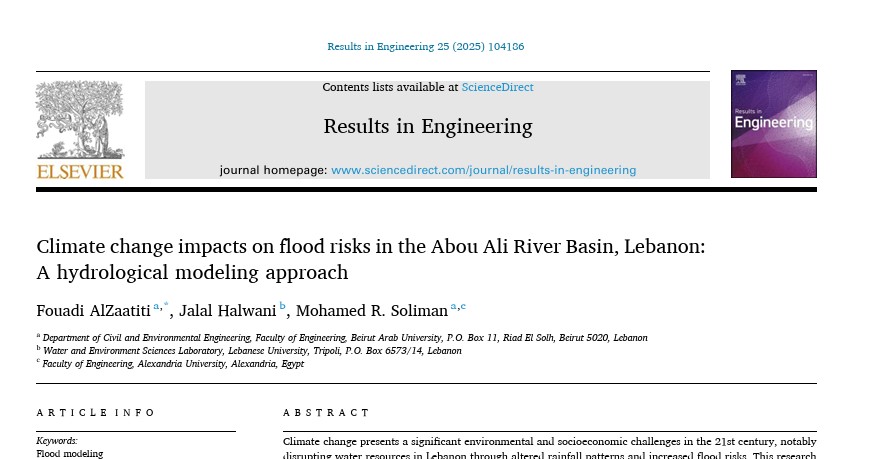Climate change impacts on flood risks in the Abou Ali River Basin, Lebanon: A hydrological modeling approach
 |
publication Jan 2025 ; 15 pages
Aut. Jalal Halwani
Ed. LU - Beirut
Téléchargeable sous format: PdF
Abstract:
Climate change presents a significant environmental and socioeconomic challenges in the 21st century, notably
disrupting water resources in Lebanon through altered rainfall patterns and increased flood risks. This research
examines the impacts of climate change on flood dynamics in the Abou Ali River Basin in Tripoli, Lebanon,
utilizing three global climate models (GCMs) from the IPCC’s 6th Assessment Report: ACCESS-CM2, BCC–CSM2-
MR, and MIROC6 under two Shared Socioeconomic Pathways (SSPs): SSP2–45 and SSP5–85. Downscaling and
bias correction were done using the CMhyd tool to ensure accuracy in the climate model projections. The findings
show an overall decrease in precipitation of -10.8 % (ACCESS-CM2) and -13.2 % (MIROC6) under SSP5–85,
respectively, aligning with broader regional trends. In contrast, BCC–CSM2-MR predicts an 8 % increase in
precipitation, under the same scenario. Flood modeling with the Rainfall-Runoff-Inundation (RRI) model reveals
a dramatic increase in inundation extent, from 8.78 km² to 26.05 km², and a rise in maximum depth from 6.5 m
to 14.7 m, with urban and agricultural areas at significant risk. This study provides crucial insights into future
flood risks in Tripoli, emphasizing proactive responses to climate change challenges.
Publics-Cibles:
Université , Socio-économiste , Décideurs locaux ou nationaux
Mots clefs: |
climat (CI) (DT) (OP) (ope) , eaux pluviales (gestion) (CI) (DT) (OP) (ope) , gestion de la ressource en eau (CI) (DT) (OP) (ope) , recherche scientifique (CI) (DT) (OP) (ope) |
Pays concerné: |
Editeur/Diffuseur: |
|
LU
-
Université Libanaise - Beirut - Liban |
En cas de lien brisé, nous le mentionner à communication@pseau.org